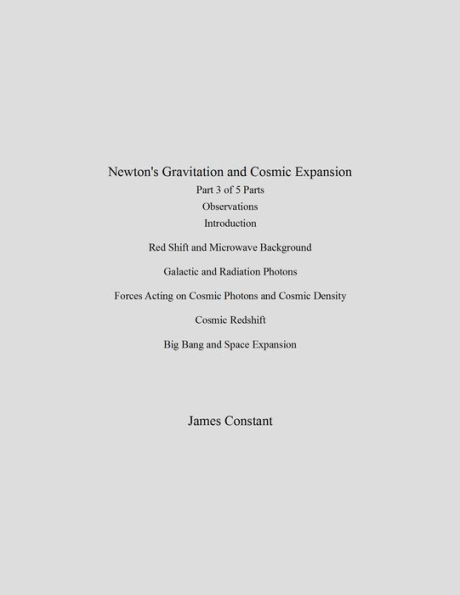This third part speculates about the sources for the observed red shifts and microwave background, and concludes that receding galaxies are sources for the observed red shifts and the extra galactic radiation is the source for the microwave background. It formulates the forces acting on cosmic photons and dependence on mass density, and talks about cosmic redshift, space expansion and the Big Bang which it discounts. It concludes stars in the Galactic Universe and radiation in the Extra Galactic Radiation Universe at the farthest distances as having a Planck blackbody spectra. Planck's black body spectrum, which characterizes the observed microwave background, discounts the idea of Big Bang because mass density is distributed at all distances. It looks at the observations of redshifts of galaxies and the microwave background and examines observations which lead to two models, the linearly and non-linearly expanding universes. The Cosmos is a finite or infinite hot ball of radiation with a cool Galactic center. Cosmic redshift is caused by forces of expansion and gravitational forces are negligible. We have two types of universes, the finite universe of radius 21.1 bly based on an extension of Hubble's linear law and the infinite universe based on relativistic doppler theory
This third part speculates about the sources for the observed red shifts and microwave background, and concludes that receding galaxies are sources for the observed red shifts and the extra galactic radiation is the source for the microwave background. It formulates the forces acting on cosmic photons and dependence on mass density, and talks about cosmic redshift, space expansion and the Big Bang which it discounts. It concludes stars in the Galactic Universe and radiation in the Extra Galactic Radiation Universe at the farthest distances as having a Planck blackbody spectra. Planck's black body spectrum, which characterizes the observed microwave background, discounts the idea of Big Bang because mass density is distributed at all distances. It looks at the observations of redshifts of galaxies and the microwave background and examines observations which lead to two models, the linearly and non-linearly expanding universes. The Cosmos is a finite or infinite hot ball of radiation with a cool Galactic center. Cosmic redshift is caused by forces of expansion and gravitational forces are negligible. We have two types of universes, the finite universe of radius 21.1 bly based on an extension of Hubble's linear law and the infinite universe based on relativistic doppler theory

Newton's Gravitation and Cosmic Expansion (III Observations)

Newton's Gravitation and Cosmic Expansion (III Observations)
Related collections and offers

Product Details
| BN ID: | 2940046219470 |
|---|---|
| Publisher: | James Constant |
| Publication date: | 10/06/2014 |
| Series: | Gravitation , #3 |
| Sold by: | Smashwords |
| Format: | eBook |
| File size: | 114 KB |
